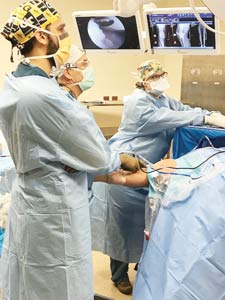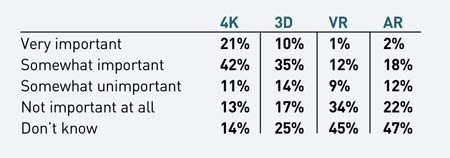We wanted to know if surgeons are liking what they’re seeing during surgery, so last month we asked readers for their thoughts on the imaging technologies used in their ORs. Most (81%) of the 104 survey respondents reported a large degree of surgeon satisfaction with their video monitors as well as excitement about the capabilities of emerging technologies such as 3D imaging, virtual reality (VR) and augmented reality (AR).
Physicians who work with 4K ultra-high-def imaging apparently love it, lauding how it leads to safer, quicker surgeries with better outcomes. “Our GI specialists say they can identify more polyps and cancers,” says Sean Floyd, RN, director of surgical services at TMC Bonham (Texas) Hospital. Adds Samir Shahin, RN, manager of perioperative services at NorthBay Healthcare in Fairfield, Calif., “Physicians are less likely to miss polyps and more likely to have cleaner screenings.”
There was much enthusiasm about the enhanced picture, color, sharpness and clarity — the “improved visualization” — that 4K provides. Lisa Seeds, RN, BSN, night supervisor of the main OR at Bon Secours St. Mary’s Hospital in Richmond, Va., says surgeons who have been using 4K monitors in the hospital’s two ORs believe the imaging systems provide a better view of the surgical cavity, making for more precise movement and technique.
“Right now, 4K is being requested for better visualization and clarity with robotic and laparoscopic cases,” says James Wade, BSN, RN, CNOR, assistant nurse manager at Legacy Health Salmon Creek in Vancouver, Wash.
“Surgeons are using 4K at other facilities and feel it makes a difference.”
However, some respondents reported that true 4K remains elusive because their entire video chain hasn’t yet been upgraded. “Our monitor does not have the specific camera or cables for 4K, so it doesn’t make much of a difference,” says one surgery coordinator.
Other advanced imaging technologies such as 3D, VR and AR are largely still not in use. Not surprisingly, cost is a major inhibitor of a movement toward adding them. “We are not currently using any of these,” says one reader.
“For our independent physicians group, the benefits would need to outweigh the additional costs and upkeep. Our surgeons may feel differently if given the option to use them in a hospital setting.”
.svg?sfvrsn=be606e78_3)


.svg?sfvrsn=56b2f850_5)